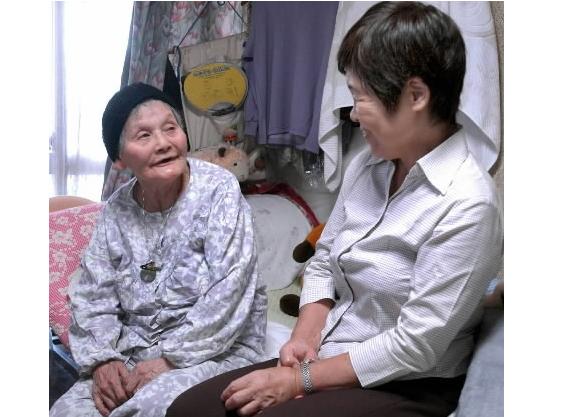Conveying the A-bomb Experience, Part 10
Jul. 5, 2010
"Conveyors" relate the truth of the atomic bombing
by Kunihiko Sakurai, Masaki Kadowaki, and Takahiro Yamase, Staff Writers
The heat of the atomic fire, the agony of burned bodies, the grief wrought by families torn apart, the rage felt toward war… What should be done to etch the experiences borne of that day in our minds and in our memories, for generations to come, as the A-bomb survivors (hibakusha) and the family members of the A-bomb victims age? In this series (originally published in July and August 2004), the Chugoku Shimbun will consider the significance and challenges of conveying the A-bomb experience, with a focus on new efforts taking place in the A-bombed city of Hiroshima.
Toshiko Saeki, 84, a resident of Higashi Ward, Hiroshima, sat on a bed in her home and began to share a rapid train of thoughts: "Some say it occurred 59 years ago. For me, 365 days a year are the days of 'Hiroshima'." "When it rains, I'm reminded of the black rain. When it's hot, I remember the strong sun that beat down on me without any trees nearby for shade."
Mitsuko Hiraoka, 62, a housewife and resident of Higashi Ward, listened to Ms. Saeki quietly, sometimes making brief responses. Since Ms. Saeki suffered a stroke in December 1998, and began to have difficulty going out, Ms. Hiraoka has visited her every month and informed her of the goings-on in Hiroshima Peace Memorial Park.
The two women developed a deep friendship by cleaning up together around the Atomic Bomb Memorial Mound in the park.
The mound holds the remains of about 70,000 people who have not been identified and remain unclaimed. From the time the mound was first built to its current form created in 1955, Ms. Saeki went to the park by bus almost every day, weeding the mound and gathering up fallen leaves.
When visitors passed by, she would call to them to stop: "Please give me just ten minutes." She then proceeded to describe the state of the city, and her own circumstances, on that day. "The stench of death was so horrible that I threw up many times." "I stepped on the hands of strangers who were crying for help. I could only continue searching for my family." The atomic bombing stole 13 family members from her, including her mother, her older brother, and her younger sister.
Ms. Saeki shared the reason why she had devoted herself to tending to the Atomic Bomb Memorial Mound: "Conveying the voices of the A-bomb victims, who cannot speak for themselves, is a duty of those who survived that day." The past 59 years, during which the number of hibakusha who can relate their A-bomb experiences has dwindled, have been painful for her. The possibility that such experiences, due to extinction and exaggeration, might morph into fabricated legend is also causing her concern: "The experience of Hiroshima will be turned into an old myth." Ms. Saeki continued, "Some hibakusha present several versions of their A-bomb experiences. They exaggerate the tragedy of their experiences and this turns off their listeners. Above all, the A-bomb victims cannot be consoled in such a way."
Ms. Saeki called Ms. Hiraoka, sitting next to her on the bed, a "conveyor."
Ms. Hiraoka was born and raised in Tokyo. She listened to Ms. Saeki's experience 15 years ago and was shocked by the great number of A-bomb victims now resting in the mound. She began to regularly visit the mound with the wish "to get close to the feelings of hibakusha." Even after Ms. Saeki became laid up, she continued to clean up around the mound once a week. Now, Ms. Hiraoka walks around the park with students visiting Hiroshima on school trips in order to show them the monuments, and introduces the A-bomb experience of Ms. Saeki.
Ikuo Teranishi, 65, a former public servant in the city of Neyagawa, Osaka Prefecture, has maintained ties to Ms. Saeki for the past 30 years. Two years ago, Mr. Teranishi adapted Ms. Saeki's life up to that point into a recitation play entitled "Hiroshima no Oka" ("The Big Mother in Hiroshima"). The play will be presented this year, too, in front of the mound on the evening of August 5.
Elementary school students and teachers regularly visit Ms. Saeki's house to record her account on tape.
The circle of "conveyors" is growing.
Ms. Hiraoka said, "It's not that I see myself as Ms. Saeki's successor. I encountered her by chance and was drawn to her way of life. I want to convey her story to many people."
With a smile, Ms. Saeki responded to Ms. Hiraoka's words: "You have encountered Hiroshima. Along your path, please convey the stories of the dead that I have shared with you." She added, "And please tell only the truth. You must not turn Hiroshima into a made-up tale."
"Please continue on this path," Ms. Saeki said.








